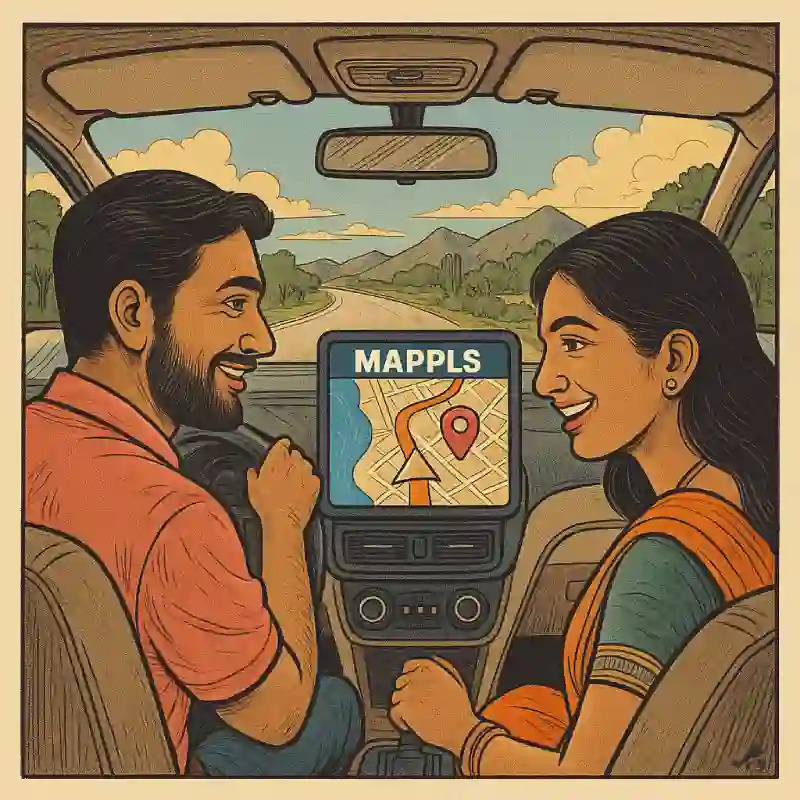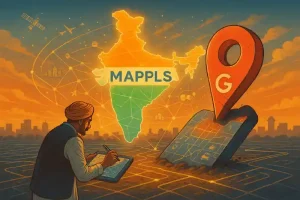As Mappls takes the wheel, India’s digital journey steers toward self-reliance — and away from Silicon Valley’s map.
India’s long-standing dependence on Google Maps may soon meet a domestic challenger. Mappls (pronounced “Map-plus”), developed by the Indian firm MapmyIndia, is fast emerging as the torchbearer of India’s campaign for digital self-reliance. More than a mapping app, it represents control over data that has long flowed through foreign systems.
Entirely developed and maintained within India, Mappls is built to keep national mapping data under domestic control rather than on foreign servers. This design choice reflects a wider policy momentum: New Delhi’s effort to build a fully indigenous digital ecosystem that covers everything from mobile payments to satellite mapping.
As the Hindustan Times article noted, Mappls’ integration across public transport apps, logistics operations, and e-governance portals shows that it’s evolving into more than a consumer product. It’s gradually becoming a symbol of India’s intent to secure its technological infrastructure, not just by innovating locally, but by ensuring that the information powering it remains sovereign.
The Infrastructure of Independence:

As we mentioned, Mappls traces its roots to MapmyIndia, a company that has spent nearly three decades building location databases for India, long before smartphones or Google Maps entered the scene. Its edge lies in granular, India-specific mapping, from rural lanes and toll data to hyperlocal landmarks and digital addresses.
Unlike Google’s ad-driven model, Mappls positions itself as privacy-first, with no location tracking for commercial targeting. It’s also the first navigation app to integrate with the government’s new DigiPIN initiative, which assigns digital coordinates to every home and business in the country. That means India’s postal system, disaster response, and delivery networks can all run on the same indigenous geocode. Beneath the patriotic gloss, this is infrastructure-level innovation, an attempt to redefine how a billion citizens interact with geography.
The company’s rise also signals a deeper philosophical shift. For decades, India’s internet backbone, from search engines to mapping to cloud storage, has been shaped by American corporations. Mappls represents an inversion of that dynamic: Indian data, Indian servers, Indian accountability. With data localization laws gaining teeth and the Centre encouraging domestic APIs through ONDC and India Stack, Mappls benefits from being in the right place at the right time.
Its partnerships with ISRO and the Ministry of Science and Technology further boost its credibility, giving it access to satellite data that was once restricted. If Google built the world’s most detailed atlas from the top down, Mappls is building India’s from the ground up.
Breaking Habits, Not Just Monopolies

For Mappls, the challenge isn’t technical so much as cultural. Google Maps has been part of the Indian smartphone experience for over a decade, guiding food deliveries, cabs, road trips, and even emergency response systems.
Undoing that level of familiarity will take time and a very different playbook. The company can’t just depend on patriotic appeal; it must compete on precision, speed, and clarity. Every delay in live traffic data or glitch in routing becomes a credibility test. Google’s biggest advantage isn’t a single app; it’s the entire web of services that work together.
Android smartphones, YouTube recommendations, Search, and Maps all feed data into one another, creating a cycle that keeps users within Google’s fold almost by default. Breaking that habit will take more than just features; Mappls has to convince users that accuracy, privacy, and national control over digital infrastructure genuinely matter. Winning that argument won’t happen overnight, but it’s a shift already underway, and one that could define how India balances convenience with control in its digital future.
The economic implications stretch far beyond maps. If Mappls proves viable as a full-stack alternative, it could set a precedent for indigenous clones of other “digital dependencies.” Much like UPI became India’s answer to Visa, or CoWIN redefined public-health data, Mappls could inspire homegrown versions of Google Earth or Waze-style mobility analytics. Its IPO success, partnerships with automotive OEMs like Hyundai and Mahindra, and integration into drone logistics systems show that this is already happening.
This moment in mapping technology is more than a fight for users or revenue. It represents India slowly taking back control over its digital infrastructure, ensuring that the data guiding daily life is managed within its borders. Each improvement to Mappls, therefore, becomes symbolic of that broader shift toward independence in technology and governance.
Navigation as a National Asset
Navigation is no longer just a convenience that helps users find routes; it has become a strategic layer of national infrastructure. Whoever controls geospatial data controls logistics, defense planning, disaster response, and even urban governance. In that sense, Mappls stands at the crossroads of policy, innovation, and sovereignty.
As it scales with government partnerships and wider public use, the conversation must move beyond replacement, from “Can it match Google?” to “Can it define India’s own digital path?” Success here would mean more than market share; it would mean embedding independence into the everyday tools of modern life.
In the decades ahead, maps may matter less for the roads they display than for the values they represent: accuracy, accountability, and autonomy.
In case you missed:
- India’s first Aatmanirbhar semiconductor chip is finally here!
- Tesla’s India Launch: It’s not about the Model Y, it’s about the AI!
- India’s first Aatmanirbhar Chip Fab: TATA leads the way!
- India’s Starlink Moment is Finally Here: Green Light from The Government!
- Slaughterbots: Robot Warriors in the Indian Armed Forces!
- India’s First Paid Chip Prototype: Kaynes Fires the Starting Shot
- Samsung’s new Android XR Headset all set to crush Apple’s Vision Pro
- 4 New Chip Fabs and a Rallying Cry from The Red Fort!
- The Sodium-Ion Breakthrough That Could Unplug Lithium’s Reign
- One Chip to Rule Them All: The 6G Chip at 100 Gbps!










